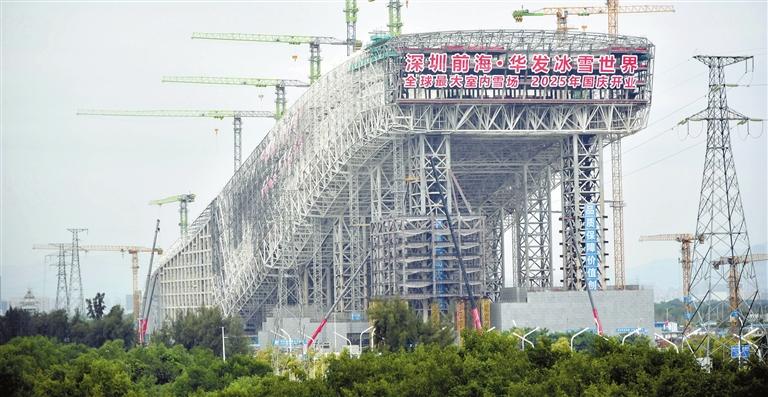




SKIS strapped on, goggles tightened, and helmet fastened, Wang Lin took a deep breath before hurtling down a 138-meter-long indoor slope, feeling the exhilarating rush of speed. For Wang, a novice skier, there is no need to travel thousands of kilometers to China’s frozen northern frontiers. Just two kilometers from her home in Wuxi, a two-hour drive from Shanghai, lies a fairy-tale-like haven whose decor and soft snow can whisk her into a winter dream. “Skiing is a huge stress reliever,” Wang said, beaming after her run. “My whole family can visit the ski resort every week. It’s incredibly convenient.” Known as Wuxi Bonski, the indoor facility spans 17,500 square meters and attracts hundreds of enthusiasts daily. Notably, around 70% of visitors hail from the Yangtze River Delta region, where sustained snowfall is a rarity. For South China dwellers who are accustomed to mild winters, a facility like this redefines winter in a region where natural snow is elusive. China’s winter sports market is on a meteoric rise. According to the latest industry report, the scale of the country’s ice-and-snow economy is expected to reach 970 billion yuan (US$133 billion) in 2024 and surpass 1 trillion yuan in 2025. Backed by government directives aiming to leverage winter sports as a catalyst for high-quality growth, the sector is forecast to expand to 1.2 trillion yuan by 2027 and 1.5 trillion yuan by 2030. As winter unfolds, ice skaters and skiers are spreading well beyond traditional northern strongholds, bringing the speed and adrenaline of winter sports to nearly every corner of the country. Snow is no obstacle Wang, who can deftly navigate green runs, is part of a growing number of winter sports enthusiasts forging a new winter culture in southern China. “People in the south have always been fascinated by snow, and the 2022 Beijing Winter Olympics truly ignited our passion for winter sports,” she said, explaining why many southerners share her enthusiasm. Beijing hosting the Winter Olympics, which inspired 300 million Chinese to take part in winter sports, proved transformative. Gone are the days when only a niche northern community embraced such pursuits. Now, seniors and youngsters alike glide across ice rinks and swoosh down indoor slopes in places where real snowfall is seldom seen. The proliferation of facilities has rendered winter sports, once an exotic and expensive pastime, more accessible than ever. Teenagers in warmer locations like Shenzhen and Shanghai now have regular training options for skating, ice hockey, and other winter sports. Data from China’s General Administration of Sport show that the number of winter sports venues nationwide reached 2,847 by the end of 2023, up 16.11% year on year. Many of these facilities are nestled in southern regions. For instance, Jiangsu now hosts about 50 ice-and-snow venues that cover more than 640,000 square meters, and around 300,000 students from 1,000 schools in the province are engaged in winter sports. In Jiangsu’s Taicang City, the 54,000-square-meter Alps Snow Live indoor ski resort, which boasts five slopes of varying gradients up to 280 meters, draws throngs of children and adults daily. In Shenzhen, a recently opened temporary outdoor snow-themed attraction at The MixC Qianhai shopping mall in Nanshan District became an instant hit, drawing large crowds. To cash in on the enthusiasm for ice and snow, other leisure destinations across Shenzhen, including the Link Central Walk in the Futian CBD, the A Park shopping mall in Futian District, The MixC Luohu shopping mall in Luohu District, and Nantou Ancient Town in Nanshan District, have also rolled out their own ice-themed installations or festivals. The subtropical city already boasts several ski resorts, including the 12,000-square-meter Karoo Ice Snow, which opened in March 2023 in Longhua District. In October next year, the city will see the completion of the Shenzhen Qianhai Huafa Ice and Snow World, which is expected to house the largest indoor ski resort in the Guangdong-Hong Kong-Macao Greater Bay Area at roughly 100,000 square meters. It will include an 83-meter ski drop and a 450-meter single ski track. For South China, a relative latecomer to winter sports, the increasing number of novices taking up skiing and snowboarding signals vast market potential. According to travel platform Ctrip, four out of the top five cities for ski-related bookings last winter were in southern China, underscoring winter sports as a major driver of consumption in milder climates. Snow starts a gold rush As enthusiasm for winter sports surges, the knock-on effects for tourism, culture, and equipment manufacturing are profound. Winter tourism, for example, boomed last season. China recorded over 385 million winter leisure visits nationwide, a year-on-year increase of 38%, with related revenue up 50%. In Harbin, a traditional winter tourism hot spot in northeastern China, last snow season saw over 87 million visitors, up 300% year on year, and 124.8 billion yuan in tourism revenue, up 500%. With the city set to host the Asian Winter Games next February, right after China’s Spring Festival holiday, the local ice-and-snow economy looks poised for another explosive season. Xu Xiaoliang, operations manager of the Alps Snow Live indoor ski resort in Jiangsu Province, believes that China holds huge promise in achieving a north-south synergy in the ice-and-snow economy. By strengthening linkages — where beginners start on southern indoor slopes before honing their skills on northern mountains — regions can pool resources and create year-round appeal. “By offering discounted tickets and bundled experiences, consumers can make their getaways more diverse, enriching travel experiences throughout the year,” Xu said. “Winter sports provide a prime opportunity for the ice-and-snow economy to transition from passive sightseeing to immersive, social, experience-based consumption,” said Wang Yuxiong, a sports economics researcher at the Central University of Finance and Economics. “They can reshape business models, enhance added value, and foster sustainable development.” Major sports events, both domestic and international, are proving their worth. China’s 14th National Winter Games, held earlier this year in the Inner Mongolia Autonomous Region, is estimated to have generated about 32 billion yuan in sports-related spending during the competition period. Moreover, China’s winter sports equipment industry is snowballing, driven by advancements in 5G, artificial intelligence, and virtual reality. Think smart ski insoles that track performance and analyze data, heated snow boots that stay warm for five hours, and VR simulators that bring alpine thrills directly into one’s living room. Currently, China boasts a comprehensive suite of 15 categories of ice-and-snow equipment across the supply chain, from headgear to footwear, individual gear to venue equipment, and competitive apparatus to recreational tools. “China’s ice-and-snow economy is a gold mine,” said Yan Yan, an associate professor at the Nanjing University of Technology. “Success hinges on crafting distinctive advantages and making winter sports irresistible to consumers.” “Under the country’s national fitness strategy, developing the ice-and-snow economy is akin to a marathon. The task is to ensure sustained effort and to inspire more people to lace up their skates, strap on their skis, and join the ride,” Yan added. (Xinhua) | 
